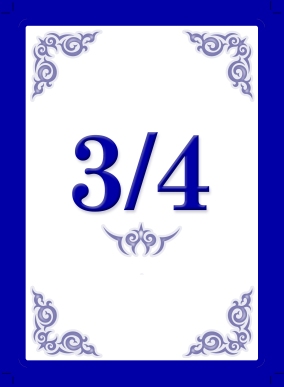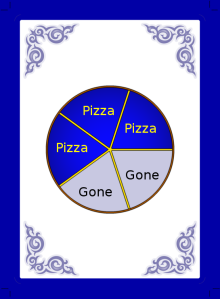
FRAX is a game to help students master fraction arithmetic and moving between fraction representation. Taking difficult subjects and turning them into games is called gamification and there is evidence that it can improve learning.
Who are we?
Andrew McEachern is currently an assistant teaching professor in the mathematics department at York University. Daniel Ashlock is a full professor in the mathematics department at the University of Guelph, in Ontario. We have spent a lot of time in elementary, high school, and university classrooms, and noticed there is a big problem with our students not being able to deal with fractions effectively. This is part of our attempt to help!
Back to basics
Click the following link to see a pdf that has some reminders about how to do fraction arithmetic!
The basis of FRAX
FRAX is based on the game Divide the Dollar. In Divide the Dollar, two players sit on opposite ends of the table and have one dollar sitting in the middle of the table. Each player secretly makes a bid for how much of that dollar they want to have. If the sum of their bids is equal to, or less than, one dollar, then they both walk away with the values of their bids.If the sum of their bids exceeds one dollar, they both walk away with nothing.
So for example, if Andrew and Dan are playing Divide the Dollar, Andrew makes a bid for 54 cents, because he’s greedy, and Dan makes a bid for 50 cents, because he’s fair, the sum of their bids is 104 cents, which is more than one dollar. At the end of the round, they both get nothing. They decide to play again, and this time Andrew bids 49 cents, and Dan bids 50 cents again. The total is 99 cents, which is less than one dollar. Andrew gets to put 49 cents in his pocket, and Dan gets to put 50 cents in his pocket. So Dan is currently winning the game, since he has more money at the moment.
Divide the dollar is simple enough, and the fairest way to play it is when both players ask for 50 cents.
What if we changed the game a bit? We wanted to change three things: the value of money in the middle of the table, and what kinds of bids a player can make, and how many players can play in the game.
Thus the card game of FRAX was born. The whole point of Divide the Dollar is to walk away with as much money as you can. If you know your opponent is only going to ask for 40 cents, then you should ask for 60 cents.
The point of FRAX is the same as Divide the Dollar. You want to end the game with more points than your opponents. There are three kinds of cards, FRAX cards, GOAL cards, and BONUS cards. The FRAX cards represent the kinds of bids you can make during the game. The GOAL cards represent the amount of points available to bid for in each round. The BONUS cards are described later.
How to play FRAX, and scoring the game
So far, there are two ways to play FRAX:
Simultaneous Play
- Select a deck of FRAX cards (see the next section for suggestions)
- Select GOAL cards (see the next section for suggestions).
- Shuffle the GOAL cards. Each round, flip over the top card. If you run out, reshuffle. Or teachers can select the GOAL card.
- Deal each player 5 FRAX cards. After each round, they get a new FRAX card from the deck.
- In each round, players pick a FRAX card from their hand and hold it so only they can see it.
- All players lay down their FRAX cards at the same time. This is different than turn-based because in the turn-based option each person selects their cards after seeing what has already been played. In the simultaneous version, all cards are played at the same time.
- If the sum of the played cards is equal to or less than value of the GOAL card, each player gets their own card back and adds the fraction amount on their card to their score. If the sum is more than the GOAL card, all cards are discarded, no player gets any points.
- If you run out of FRAX cards, reshuffle the discard pile.
- The winner is the student with the highest total score; ties are possible.
Using BONUS! cards
The BONUS! cards are used to spice up play. In the simultaneous game, when the cards are revealed, the players may say “score” or “fail”. The first player to say the correct thing gets a bonus card, if they can demonstrate why they are right. If the first player to say something is wrong, or can’t show why they are right, they give back a bonus card if they have one. If a player is wrong twice in a row, they can’t say “score” or “fail” for the next three rounds. The bonus cards a player has at the end of play are added to their score.
Turn-based Play
- Select a deck of FRAX cards (see the next section for suggestions).
- Select GOAL cards (see the next section for suggestions).
- Shuffle the GOAL cards. Each round, flip over the top card. If you run out, re-shuffle. Or teachers can select the GOAL card.
- Deal each player 5 FRAX cards. After each round, they get a new FRAX card from the deck.
- Select a player to go first. Going counterclockwise, each player plays a card. If the sum of the played cards is equal to or less than the value of the GOAL card, each player gets their own card back and adds the fraction amount on their card to their score. If the sum is more than the GOAL card, all cards are discarded, and no player gets any points.
- The player that goes first rotates counterclockwise after each round.
- Each player should get to be first an equal number of times. If you run out of FRAX cards, reshuffle the discard pile.
- The winner is the student with the highest total score; ties are possible.
The following video has a few rounds of the simultaneous version of FRAX being played.
Be sure to read the following pdf!
It has examples of how the scoring is done, and a few example rounds of play.
Selecting a deck to play FRAX.
After some feedback, here are some ways to put together a smaller deck from the main deck:
4 people
If you want an easy game of FRAX, where many rounds end in a score, use the following:
Use all of the GOAL cards equal to 1, 1 1/6, 1 1/5, 1 1/3, 1 1/2, 1 3/4, and 2. Use all of the FRAX cards with values 1/4, 1/2, and 3/4 cards, including the picture cards
If you want a medium game of FRAX, where not every round will end in a score, use the following:
Use all of the GOAL cards equal to 1, 1 1/6, 1 1/5, 1 1/3, 1 1/2, 1 3/4, and 2. Use all of the FRAX cards with values 1/4 and 3/4 cards, including the picture cards, but only include 9 of the 1/2 cards, instead of the full set of 18.
If you want a harder game of FRAX:
Use all of the GOAL cards equal to 1, 1 1/6, 1 1/5, 1 1/3, 1 1/2, 1 3/4, and 2. Use all of the FRAX cards with values 1/4 and 3/4 cards, including the picture cards, but only include 3 of the 1/2 cards, instead of the full set of 18.
For 6 or more people
For a medium game, use all of the GOAL cards. Use all of the FRAX cards except the 1/6, 2/6, 3/6, 4/6, and 5/6 cards and the related FRAX cards with pictures, and use 9 of the 1/2 cards.
For a hard game, use all of the GOAL and FRAX cards but remove all of the 1/2 cards from the FRAX deck.
A FRAX set has 200 cards including cards with three different sorts of fractions on them — classical fractions, arrays of dots, and pizza slices. To play you need a deck of about 60 cards, taken from the 200 cards in every FRAX deck. All of the players use the deck of about 60 cards, plus you need to select some goal cards. You can mix the different types of fractions (meaning pictures and numbers, but also fractions with different denominators) but it may be easier to start with just one type.
Here is what we currently know about selecting a deck. You feedback would be especially valuable in updating our understanding of deck selection.
- Your goal cards should have several values centered around something a little larger than half the number of people playing.
- For an easier game, keep the denominators in the same family of fractions. A mixture of halves and quarters is pretty easy — but be careful! If all the cards are small the game is too easy because everyone scores every time. No skill is required to win, just luck of the draw.
- The more large cards you have, the harder it is to score. A good way to go is to deal out large and small cards in pairs and then add medium-sized cards.
- “Medium sized” is about half the size of your middle goal card. The more medium-sized cards there are, the easier the game gets, all other things being equal.
- Mixing up several different families of denominators makes a more challenging game, as does mixing the fraction representations (numbers, dot clouds, pizza).
So, for a two player game, goals cards should be centered around something a little larger than one, and one-half is a “medium” card. A deck of one- and three-fourths and one-halves would be a good deck for learning FRAX; the one-halves should be the most common.
An example deck with four people would include 2 goal cards with 1 1/3 as a value, 2 goal cards with 1 1/2, 3 2 goal cards with 1 3/4, and 3 goal cards with a value of 2. For a deck that is easy to play with, you could include 24 FRAX cards with value 1/2, 15 FRAX cards with a value of 1/4 and 15 FRAX cards with a value of 3/4. To make the game more interesting, consider keeping that distribution of cards, but begin to add more cards with different denominators, such as the 1/3 cards. Don’t forget to add larger values as well as smaller values, otherwise the game will always result in a score, which gets boring after a while.
You will need to adjust the decks as the size of the group changes. We have some ideas about this, but we need your help refining it! Please contact Andrew if you want deck suggestions for a specific group of players.
We recommend that you experiment with the goal decks and the FRAX cards. You are also welcome to create your own goal card values, and please tell us which ones you use!
Other ways to us FRAX cards
We’ve gotten some feedback so far about teachers and parents using the FRAX cards for other purposes, and we cannot encourage this enough! If you like our cards for other reasons, we want you to use them, and tell us about it! If you feel like you don’t quite have a handle on the game we proposed, by all means, please use the cards in another way that you are comfortable with, and have fun.
So far, we’ve seen people playing with the FRAX cards in the following way:
- FRAX War, which is played like a standard game of War, except with FRAX cards
- Matching games, where you lay out a bunch of cards and two players try and match different representations together.
Fraction and representation comparison games are useful to help develop mastery. There are multiple representations for fractions in a FRAX deck, and part of fraction mastery is being able to say the following two cards are the same value:


Where did FRAX come from?
A long time ago, Dan and his student Elizabeth Knowles did a research project on what would happen if you turned the game prisoner’s dilemma into a card game. Dan and Justin Schonfeld developed a general theory of making card games from abstract math games. The staff here at Dan and Andrew’s went on to invent FRAX and we’ve published one paper on how to design decks for FRAX.
Suggestions and Errata
We are putting the ideas (and corrections) we get from play testers here. This page is a living document and will keep getting updated. Here we go!
Which part of the pizza is pizza and which is eaten already?
The following pdf tells you exactly how to read the cards
In future editions we will add pepperoni or mushrooms! The following pizza fraction, for example, is three-fifths.

Some of the cards say FRAX on the front, some don’t?
D’oh! Ignore the extra FRAXes, please. The moral of this story is “double check the files you send to the printer.” This will be corrected in the next printing.
We are Dan and Andrew of Dan and Andrew’s Gaming Place. Let us know what you think about this post in the comments. If you get ideas from this, give us a pointer!

Andrew, Jeff O’Brien from the Phillies in the SVBL. I’ve struggled with teaching fractions to my Grade 6 class for two decades now. I use several other games successfully to teach multiples, factors and order of operations. I use one game to assist in the identification of improper fractions and mixed numbers, but would love to try your FRAX game if you are still offering samples.
LikeLike
Right now we are out of decks and trying to order more. I will be in touch when we manage it.
LikeLike